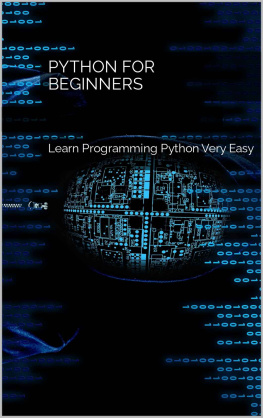Hanks Gideon - Python Programming For Beginners: A step-by-Step Guide to Coding Using Python 3 for Beginners to Pro
Here you can read online Hanks Gideon - Python Programming For Beginners: A step-by-Step Guide to Coding Using Python 3 for Beginners to Pro full text of the book (entire story) in english for free. Download pdf and epub, get meaning, cover and reviews about this ebook. year: 2020, genre: Computer. Description of the work, (preface) as well as reviews are available. Best literature library LitArk.com created for fans of good reading and offers a wide selection of genres:
Romance novel
Science fiction
Adventure
Detective
Science
History
Home and family
Prose
Art
Politics
Computer
Non-fiction
Religion
Business
Children
Humor
Choose a favorite category and find really read worthwhile books. Enjoy immersion in the world of imagination, feel the emotions of the characters or learn something new for yourself, make an fascinating discovery.

- Book:Python Programming For Beginners: A step-by-Step Guide to Coding Using Python 3 for Beginners to Pro
- Author:
- Genre:
- Year:2020
- Rating:4 / 5
- Favourites:Add to favourites
- Your mark:
- 80
- 1
- 2
- 3
- 4
- 5
Python Programming For Beginners: A step-by-Step Guide to Coding Using Python 3 for Beginners to Pro: summary, description and annotation
We offer to read an annotation, description, summary or preface (depends on what the author of the book "Python Programming For Beginners: A step-by-Step Guide to Coding Using Python 3 for Beginners to Pro" wrote himself). If you haven't found the necessary information about the book — write in the comments, we will try to find it.
Hanks Gideon: author's other books
Who wrote Python Programming For Beginners: A step-by-Step Guide to Coding Using Python 3 for Beginners to Pro? Find out the surname, the name of the author of the book and a list of all author's works by series.
Python Programming For Beginners: A step-by-Step Guide to Coding Using Python 3 for Beginners to Pro — read online for free the complete book (whole text) full work
Below is the text of the book, divided by pages. System saving the place of the last page read, allows you to conveniently read the book "Python Programming For Beginners: A step-by-Step Guide to Coding Using Python 3 for Beginners to Pro" online for free, without having to search again every time where you left off. Put a bookmark, and you can go to the page where you finished reading at any time.
Font size:
Interval:
Bookmark:

- The various kind of inputs will be provided
- The various kind of outputs to be expected.
- The various processing or processes to be done.
- To create pay checks
- To display or print associated reports.
- Numeric
- Character
- Numeric datatypes : These are variables that can only contain numbers like persons age, commodity prices. It is usually used in arithmetic operations.
- Character datatypes : These are variable that usually contain combination of numbers, letters, and special characters. It is usually implemented in persons or things address and also name of persons or things. On a more important note, it cannot be used for calculation even if they contain only numbers.
- Declaring variables : When allocating values to memory in a program, it is very essential someone declares the variable, therefore the datatype of the variable is identified on the type of data to be stored in it.
- The beginning letter of the variable always or may indicate the datatype used. For example, we make use of N or Char to signify a character or numeric as in Char Name, Nphone.
- The name of the variable must clearly describe its purpose. For example, Nresult is a numeric variable to store the score result.
- Another form is when the variable name is multiple words, each first letter of the word could be capitalized for readability. For example;
- Arithmetic operators
- Relational operators
- Logical operators.
- Arithmetic operators :
- Relational operators :
- Logical operators :
Font size:
Interval:
Bookmark:
Similar books «Python Programming For Beginners: A step-by-Step Guide to Coding Using Python 3 for Beginners to Pro»
Look at similar books to Python Programming For Beginners: A step-by-Step Guide to Coding Using Python 3 for Beginners to Pro. We have selected literature similar in name and meaning in the hope of providing readers with more options to find new, interesting, not yet read works.
Discussion, reviews of the book Python Programming For Beginners: A step-by-Step Guide to Coding Using Python 3 for Beginners to Pro and just readers' own opinions. Leave your comments, write what you think about the work, its meaning or the main characters. Specify what exactly you liked and what you didn't like, and why you think so.


